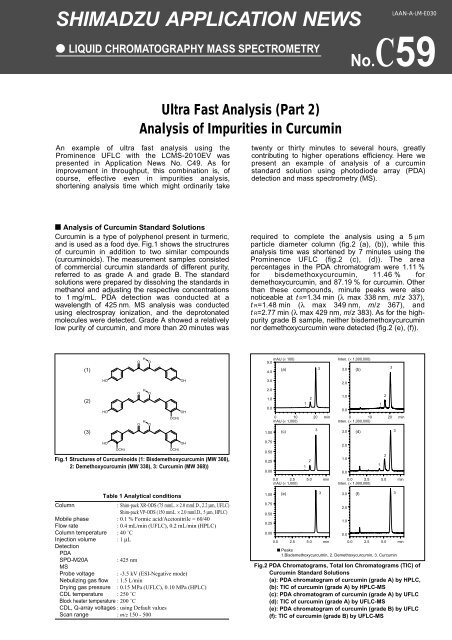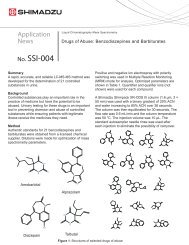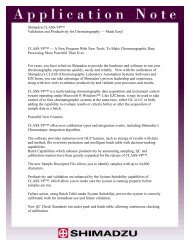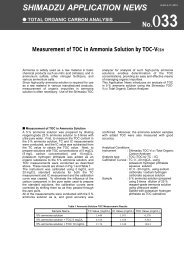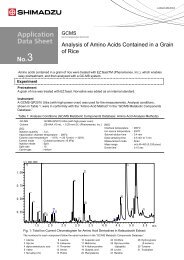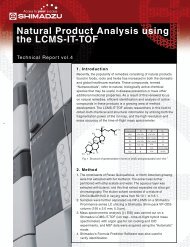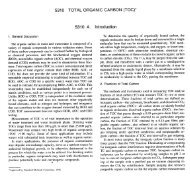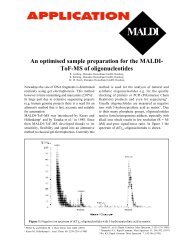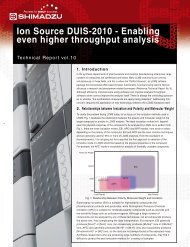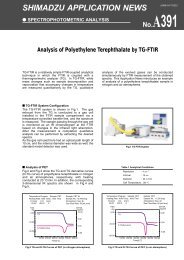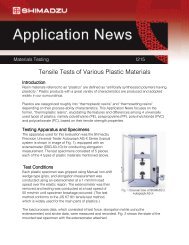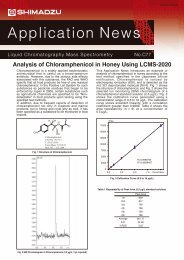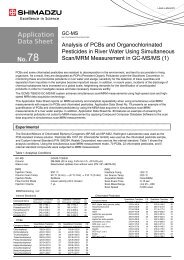Analysis of Impurities in Curcumin - Shimadzu
Analysis of Impurities in Curcumin - Shimadzu
Analysis of Impurities in Curcumin - Shimadzu
Create successful ePaper yourself
Turn your PDF publications into a flip-book with our unique Google optimized e-Paper software.
SHIMADZU APPLICATION NEWS<br />
● LIQUID CHROMATOGRAPHY MASS SPECTROMETRY<br />
Ultra Fast <strong>Analysis</strong> (Part 2)<br />
<strong>Analysis</strong> <strong>of</strong> <strong>Impurities</strong> <strong>in</strong> Curcum<strong>in</strong><br />
An example <strong>of</strong> ultra fast analysis us<strong>in</strong>g the<br />
Prom<strong>in</strong>ence UFLC with the LCMS-2010EV was<br />
presented <strong>in</strong> Application News No. C49. As for<br />
improvement <strong>in</strong> throughput, this comb<strong>in</strong>ation is, <strong>of</strong><br />
course, effective even <strong>in</strong> impurities analysis,<br />
shorten<strong>in</strong>g analysis time which might ord<strong>in</strong>arily take<br />
■ <strong>Analysis</strong> <strong>of</strong> Curcum<strong>in</strong> Standard Solutions<br />
Curcum<strong>in</strong> is a type <strong>of</strong> polyphenol present <strong>in</strong> turmeric,<br />
and is used as a food dye. Fig.1 shows the structrures<br />
<strong>of</strong> curcum<strong>in</strong> <strong>in</strong> addition to two similar compounds<br />
(curcum<strong>in</strong>oids). The measurement samples consisted<br />
<strong>of</strong> commercial curcum<strong>in</strong> standards <strong>of</strong> different purity,<br />
referred to as grade A and grade B. The standard<br />
solutions were prepared by dissolv<strong>in</strong>g the standards <strong>in</strong><br />
methanol and adjust<strong>in</strong>g the respective concentrations<br />
to 1 mg/mL. PDA detection was conducted at a<br />
wavelength <strong>of</strong> 425 nm. MS analysis was conducted<br />
us<strong>in</strong>g electrospray ionization, and the deprotonated<br />
molecules were detected. Grade A showed a relatively<br />
low purity <strong>of</strong> curcum<strong>in</strong>, and more than 20 m<strong>in</strong>utes was<br />
Fig.1 Structures <strong>of</strong> Curcum<strong>in</strong>oids (1: Bisdemethoxycurcum<strong>in</strong> (MW 308),<br />
2: Demethoxycurcum<strong>in</strong> (MW 338), 3: Curcum<strong>in</strong> (MW 368))<br />
Column<br />
(1)<br />
(2)<br />
(3)<br />
Mobile phase<br />
Flow rate<br />
Column temperature<br />
Injection volume<br />
Detection<br />
PDA<br />
SPD-M20A<br />
MS<br />
Probe voltage<br />
Nebuliz<strong>in</strong>g gas flow<br />
Dry<strong>in</strong>g gas pressure<br />
CDL temperature<br />
HO OH<br />
HO OH<br />
HO OH<br />
OCH3 OCH3<br />
Table 1 Analytical conditions<br />
: Shim-pack XR-ODS (75 mmL. × 2.0 mmI.D., 2.2 µm, UFLC)<br />
Shim-pack VP-ODS (150 mmL. × 2.0 mmI.D., 5 µm, HPLC)<br />
: 0.1 % Formic acid/Acetonitrile = 60/40<br />
: 0.4 mL/m<strong>in</strong> (UFLC), 0.2 mL/m<strong>in</strong> (HPLC)<br />
: 40 ˚C<br />
: 1 µL<br />
: 425 nm<br />
H<br />
O O<br />
H<br />
O O<br />
H<br />
O O<br />
OCH3<br />
: -3.5 kV (ESI-Negative mode)<br />
: 1.5 L/m<strong>in</strong><br />
: 0.15 MPa (UFLC), 0.10 MPa (HPLC)<br />
: 250 ˚C<br />
Block heater temperature : 200 ˚C<br />
CDL, Q-array voltages : us<strong>in</strong>g Default values<br />
Scan range<br />
: m/z 150 - 500<br />
LAAN-A-LM-E030<br />
No.C59<br />
twenty or thirty m<strong>in</strong>utes to several hours, greatly<br />
contribut<strong>in</strong>g to higher operations efficiency. Here we<br />
present an example <strong>of</strong> analysis <strong>of</strong> a curcum<strong>in</strong><br />
standard solution us<strong>in</strong>g photodiode array (PDA)<br />
detection and mass spectrometry (MS).<br />
required to complete the analysis us<strong>in</strong>g a 5 µm<br />
particle diameter column (fig.2 (a), (b)), while this<br />
analysis time was shortened by 7 m<strong>in</strong>utes us<strong>in</strong>g the<br />
Prom<strong>in</strong>ence UFLC (fig.2 (c), (d)). The area<br />
percentages <strong>in</strong> the PDA chromatogram were 1.11 %<br />
for bisdemethoxycurcum<strong>in</strong>, 11.46 % for<br />
demethoxycurcum<strong>in</strong>, and 87.19 % for curcum<strong>in</strong>. Other<br />
than these compounds, m<strong>in</strong>ute peaks were also<br />
noticeable at t R=1.34 m<strong>in</strong> (λ max 338 nm, m/z 337),<br />
t R=1.48 m<strong>in</strong> (λ max 349 nm, m/z 367), and<br />
t R=2.77 m<strong>in</strong> (λ max 429 nm, m/z 383). As for the highpurity<br />
grade B sample, neither bisdemethoxycurcum<strong>in</strong><br />
nor demethoxycurcum<strong>in</strong> were detected (fig.2 (e), (f)).<br />
mAU (× 100)<br />
5.0<br />
(a)<br />
4.0<br />
3.0<br />
2.0<br />
1.0<br />
0.0<br />
1.00<br />
0.75<br />
0.50<br />
0.25<br />
0.00<br />
1.00<br />
0.75<br />
0.50<br />
0.25<br />
2<br />
1<br />
3<br />
Inten. (× 1,000,000)<br />
0 10 20 m<strong>in</strong> 0 10 20 m<strong>in</strong><br />
mAU (× 1,000)<br />
Inten. (× 1,000,000)<br />
(c)<br />
3<br />
3.0 (d)<br />
1<br />
2<br />
0.0 2.5 5.0 m<strong>in</strong> 0.0 2.5 5.0 m<strong>in</strong><br />
mAU (× 1,000)<br />
Inten. (× 1,000,000)<br />
(e) 3 3.0 (f)<br />
3<br />
0.00<br />
0.0<br />
0.0 2.5 5.0 m<strong>in</strong> 0.0 2.5 5.0 m<strong>in</strong><br />
■ Peaks<br />
1.Bisdemethoxycurcum<strong>in</strong>, 2. Demethoxycurcum<strong>in</strong>, 3. Curcum<strong>in</strong><br />
Fig.2 PDA Chromatograms, Total Ion Chromatograms (TIC) <strong>of</strong><br />
Curcum<strong>in</strong> Standard Solutions<br />
(a): PDA chromatogram <strong>of</strong> curcum<strong>in</strong> (grade A) by HPLC,<br />
(b): TIC <strong>of</strong> curcum<strong>in</strong> (grade A) by HPLC-MS<br />
(c): PDA chromatogram <strong>of</strong> curcum<strong>in</strong> (grade A) by UFLC<br />
(d): TIC <strong>of</strong> curcum<strong>in</strong> (grade A) by UFLC-MS<br />
(e): PDA chromatogram <strong>of</strong> curcum<strong>in</strong> (grade B) by UFLC<br />
(f): TIC <strong>of</strong> curcum<strong>in</strong> (grade B) by UFLC-MS<br />
3.0<br />
2.0<br />
1.0<br />
0.0<br />
2.0<br />
1.0<br />
0.0<br />
2.0<br />
1.0<br />
(b)<br />
1<br />
1<br />
2<br />
2<br />
3<br />
3
No.C59<br />
■ PDA Data<br />
Fig.3 shows the UV spectra <strong>of</strong> curcum<strong>in</strong>oids. All <strong>of</strong><br />
them clearly possess a maximum absorption<br />
wavelength near 420 nm. When the peak purity is<br />
mAU<br />
17.5<br />
(1)<br />
15.0<br />
12.5<br />
10.0<br />
7.5<br />
5.0<br />
2.5<br />
200<br />
246<br />
Fig.3 UV Spectra <strong>of</strong> Curcum<strong>in</strong>oids (1: Bisdemethoxycurcum<strong>in</strong>, 2: Demethoxycurcum<strong>in</strong>, 3: Curcum<strong>in</strong>)<br />
Fig.4 Purity Curves <strong>of</strong> Curcum<strong>in</strong>oids (1: Bisdemethoxycurcum<strong>in</strong>, 2: Demethoxycurcum<strong>in</strong>, 3: Curcum<strong>in</strong>)<br />
■ Another Impurity<br />
Focus<strong>in</strong>g on the peak (compound X) at 5.35 m<strong>in</strong>utes<br />
<strong>in</strong> the mass chromatograms <strong>of</strong> fig.4 (2), the UV<br />
spectrum and mass spectrum were obta<strong>in</strong>ed for this<br />
peak, as shown <strong>in</strong> the fig.5. The maximum absorption<br />
wavelength is <strong>in</strong> the vic<strong>in</strong>ity <strong>of</strong> 370 nm, and the m/z<br />
417<br />
mAU mAU<br />
150<br />
125<br />
(2) 421<br />
1000<br />
900<br />
800<br />
(3)<br />
600<br />
0.0 0 0<br />
Fig.5 Mass chromatograms <strong>of</strong> curcum<strong>in</strong> standard solution (grade A, (a)) and UV spectrum (b), mass spectrum (c) <strong>of</strong> compound X<br />
SHIMADZU CORPORATION. International Market<strong>in</strong>g Division<br />
3. Kanda-Nishikicho 1-chome, Chiyoda-ku, Tokyo 101-8448, Japan Phone: 81(3)3219-5641 Fax. 81(3)3219-5710<br />
Cable Add.:SHIMADZU TOKYO<br />
100<br />
75<br />
50<br />
25<br />
240<br />
calculated from the grade A data, an impurity was<br />
detected at 5.35 m<strong>in</strong>utes (fig.4 (2)).<br />
300 400 500 nm 200 300 400 500 nm 200 300 400 500 nm<br />
0.85<br />
0.80<br />
0.75<br />
0.70<br />
0.65<br />
0.60<br />
Purity Curves<br />
Zero L<strong>in</strong>e<br />
mAU<br />
peak 15.0<br />
(1) 14.0<br />
13.0<br />
12.0<br />
11.0<br />
Purity Curves<br />
Zero L<strong>in</strong>e<br />
0.6<br />
0.5<br />
0.4<br />
mAU<br />
peak<br />
130<br />
(2)<br />
120<br />
110<br />
100<br />
0.9<br />
Purity Curves<br />
Zero L<strong>in</strong>e<br />
0.8<br />
0.7<br />
mAU<br />
peak 900<br />
(3)<br />
800<br />
700<br />
0.55<br />
10.0<br />
90 0.6<br />
600<br />
0.50<br />
0.45<br />
0.40<br />
9.0<br />
8.0<br />
0.3<br />
0.2<br />
80<br />
70<br />
0.5<br />
500<br />
0.35<br />
7.0<br />
60<br />
0.4<br />
400<br />
0.30<br />
0.25<br />
0.20<br />
6.0<br />
5.0<br />
4.0<br />
0.1<br />
0.0<br />
50<br />
40<br />
0.3<br />
0.2<br />
300<br />
0.15<br />
0.10<br />
0.05<br />
3.0<br />
2.0<br />
-0.1<br />
30<br />
20 0.1<br />
200<br />
100<br />
0.00<br />
1.0 -0.2<br />
10<br />
0.0<br />
0.0 0<br />
0<br />
4.2 4.3 4.4 4.5 m<strong>in</strong> 5.00 5.25<br />
m<strong>in</strong><br />
5.75 6.00 6.25 6.50 m<strong>in</strong><br />
Inten. (× 1,000,000)<br />
3.50<br />
3.25 (a)<br />
3.00<br />
2.75<br />
2.50<br />
2.25<br />
2.00<br />
1.75<br />
1.50<br />
1.25<br />
1.00<br />
0.75<br />
0.50<br />
0.25<br />
0.00<br />
0.0<br />
■Peaks<br />
1. Bisdemethoxycurcum<strong>in</strong>,<br />
2. Demethoxycurcum<strong>in</strong>,<br />
3. Curcum<strong>in</strong><br />
1<br />
2<br />
X<br />
3<br />
TIC<br />
m/z307<br />
m/z337<br />
m/z369<br />
m/z367<br />
1.0 2.0 3.0 4.0 5.0 6.0 7.0 m<strong>in</strong><br />
NOTES:<br />
✽This Application News has been produced and edited us<strong>in</strong>g <strong>in</strong>formation that was available when the<br />
data was acquired for each article. This Application News is subject to revision without prior notice.<br />
700<br />
600<br />
500<br />
400<br />
300<br />
200<br />
100<br />
263<br />
426<br />
369 negative ion was detected. Therefore, the<br />
molecular weight <strong>of</strong> compound X is presumed to 370.<br />
Thus, by us<strong>in</strong>g both PDA and MS <strong>in</strong> UFLC detection,<br />
greater efficiency is believed to be possible.<br />
10.0<br />
(× 1,000,000)<br />
(b)<br />
7.5<br />
5.0<br />
373<br />
2.5<br />
0.0<br />
255<br />
282<br />
200 300 400 500 nm<br />
Inten. (× 10,000)<br />
6.0<br />
5.0<br />
4.0<br />
3.0<br />
2.0<br />
(c)<br />
369<br />
1.0<br />
169<br />
397<br />
0.0<br />
200 300 400 m/z<br />
Pr<strong>in</strong>ted <strong>in</strong> Japan 3100-02801-10A-IK


